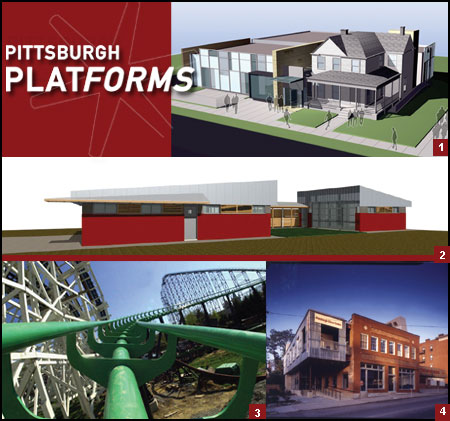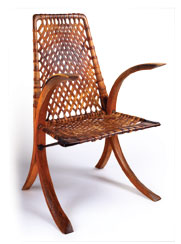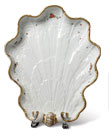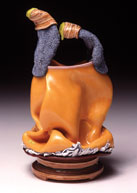
Pittsburgh Platforms
New Projects in Architecture
+ Environmental Design
By Ellen S. Wilson
Reusing the Old to Create Something Uniquely New
What
issues characterize local design culture? Do
certain areas or industries give rise to especially
innovative design? These and other questions or themes
arise as visitors wander through the archipelago
of
platforms containing the 19 projects chosen by Curator
of Architecture Raymund Ryan for his first exhibition
at Carnegie Museum of Art’s Heinz Architectural
Center. Each project was produced by architects,
landscape architects, or artists based or trained
in Pittsburgh. The
projects are grouped into five categories: home,
work, engineering, landscape, and culture; one prevailing
theme is reuse.
The Shepler House and Studio, for
example, designed by William Shepler, makes use of
recycled glass-content
tiles and recycled rice paper wall coverings. The
offices of Red House Communications, designed by
Celento Henn
Architects + Designers, incorporates old windows
and doors, while The Maridon Museum, designed by
SPRINGBOARD
Architecture, Communication, Design, joins an 1870s
house and a former car dealership to form a new
museum in Butler. Even the Phantom’s Revenge,
Kennywood Park’s famous roller coaster, conceived
by Harry Henninger Jr. and designed by Morgan Manufacturing,
reuses segments of the original Phantom’s tracks and station platform, as well as its car
chassis.
The reuse of materials in new construction
is one
of the most effective ways to be sensitive to
a building’s
impact on the environment. Another theme shared
by most of these projects is energy—how
much energy the project requires, ways to use
natural
resources
such as sunlight or water, or reactions to the
energy industry’s ecologic impact. The
environmental engineering by Burt Hill Kosar
Rittelmann Associates
for the David L. Lawrence Convention Center takes
advantage of convection currents off the river,
as well as the
roof’s shape, to provide ventilation, while
natural light provides much of the interior lighting.
The walls
in the River Lofts, proposed structures floating
on disused gravel barges, designed by Pfaffmann
+ Associates,
will contain tubes filled with river water for
heating and cooling. The Pittsburgh Glass Center,
designed
by dggp architecture with Bruce Lindsey, aims
for a LEED (Leadership in Energy and Environmental
Design)
gold rating. The center recycles 90 percent of
the heat from its furnaces and used recycled
and
energy-efficient
materials in its construction.
The emphasis of
this exhibition is on design process, conveyed
by drawings, photographs, models,
and
samples of materials used. These and the other
projects present
a portrait of an industrial city that increasingly
appreciates its past while facing, with confidence
and flair, a radically different, post-industrial
future.
Back to Contents
Very Familiar:
Celebrating 50 Years of Collecting Decorative Arts
November 8, 2003 through
January 11, 2004
 Wharton
Esherick Wharton
Esherick
(American, 1887-1970),
Chair, n.d., wood and leather,
Decorative Arts Purchase Fund
The department of Decorative
Arts at Carnegie Museum of Art was formally created
in 1953 with a grant
from the Sarah Scaife Foundation and the appointment
of
the first curator, Herbert P. Weissberger. With
additional funding from the Sarah Scaife Foundation,
as well
as funds or gifts from other sources, the department
was
able to make significant early purchases, such
as Meissen porcelain from the Swan Service. A gift
by
the Hearst
Foundation of two late-17th century French tapestries
once owned by King Louis Philippe of France was
another important early acquisition.
Beginning in November, Carnegie Museum of Art will
take a look back at the department’s
philosophy as well as its history through the
exhibition Very
Familiar: Celebrating 50 Years of Decorative
Arts. This special exhibition will provide
an opportunity
to consider some of the themes that run through
the museum’s collection, such as the
relationship of East and West, increasing industrialization,
and
how new materials and technologies or cultural
and social activities affect the decorative
arts. It also
will examine the definitions and boundaries
of decorative arts, how they relate to the
traditional idea of contemporary
art, and the role of craft media in a museum’s
collecting patterns.
The exhibition complements Strangely Familiar:
Design and Everyday Life, an examination of
contemporary design
culture, which opens in the Heinz Architectural
Center and in the Heinz Galleries on November
8. Meissen Factory
(German, 1710 - Present),Tray (in form of shell),
c.1737-1740, Porcelain
Purchase: Gift of Sarah Mellon Scaife Foundation Decorative Arts Symposium
New Reflections: Pittsburgh Glass, 1797 to the Present
Monday, October 20
9 a.m.-1:30 p.m.
CMA Theater
The first glass factory in Pittsburgh opened in
1797, and the glass industry has played a key role
in the
city’s growth and economy ever since. Two speakers,
Arlene Palmer Schwind, an independent museum consultant,
and Anne Madarasz, chief curator at the Historical
Society of Western Pennsylvania, will share their experience
and insights into the story of Pittsburgh glass at
the 26th annual Women’s Committee Decorative
Arts Symposium.
For more information or to make a reservation,
call 412.622.3208. Cost is $50
per person.
Back to Contents
Recent Acquisition:
Pottery by Kathy Butterly
 Kathy
Butterly, (American, b. 1963), Kathy
Butterly, (American, b. 1963),
Trip, 2002, ceramic, A.W. Mellon Acquisition
Endowment Fund and Martha Mack Lewis Fund
The work of American artist Kathy Butterly is full
of humor, sexiness, and California funk, says Curator
of Contemporary Art Laura Hoptman. Butterly’s
ceramics, more sculpture than pottery, are small vessels,
no more than eight inches high, with glazes influenced
by the colors of Indian miniatures.
Roberta Smith, writing in the New York Times, called
Butterly “a genius of clay, stoneware and glaze,
a miniaturist of Fabergé refinement and in her
own way, one of the best artists of our time.”
Butterly's
work follows on from the ceramic ideas explored by
artists like Ken Price and Ron Nagle. All three
produce vessels that are small, intensely complex,
and vividly colored. Price and Nagle are represented
in the museum's collection, having been acquired
by the Decorative Arts department. The Butterly is
a joint
purchase by the Contemporary and Decorative Arts
Departments and signals the growing inclusiveness of
contemporary
art and disappearance of the old classifications
of artists by media.
Born in New York in 1963, Butterly
received her BFA from Moore College of Art in Philadelphia
in 1986
and her MFA from the University of California at
Davis
in 1990, where she studied with ceramicist Robert
Arneson before his death in 1992. Back to Contents |